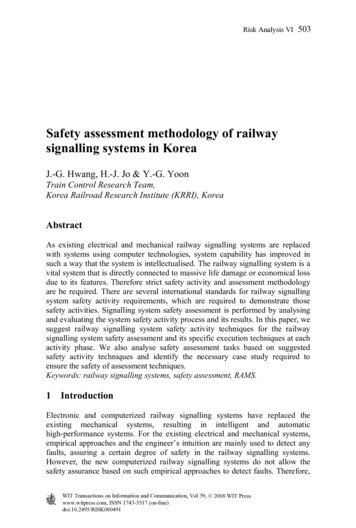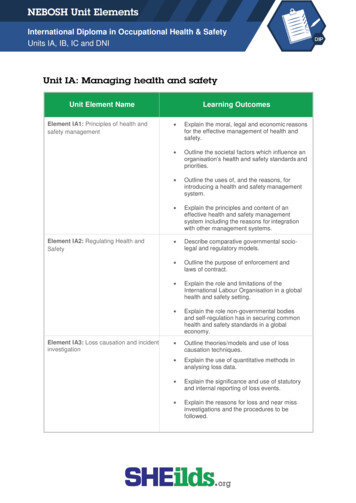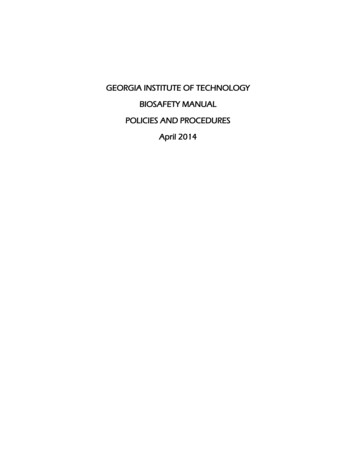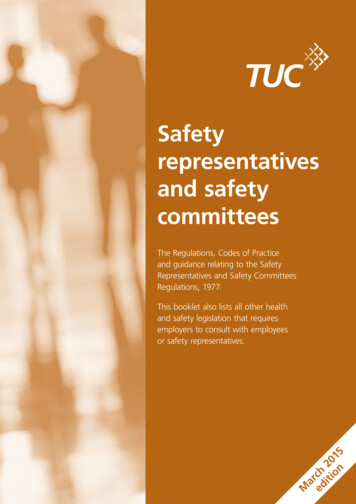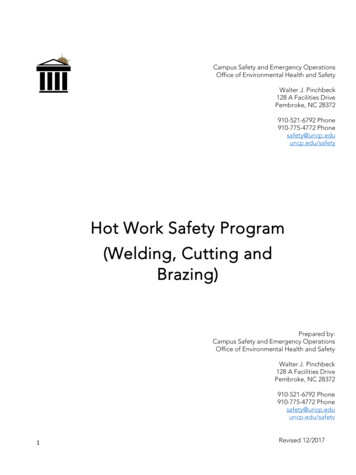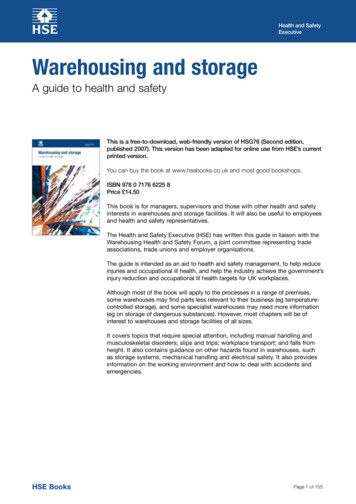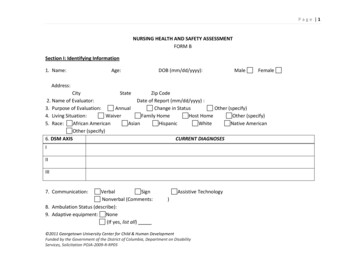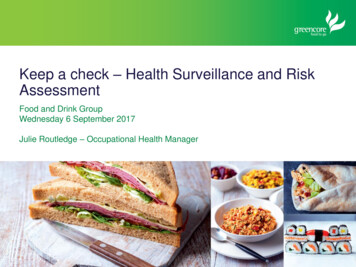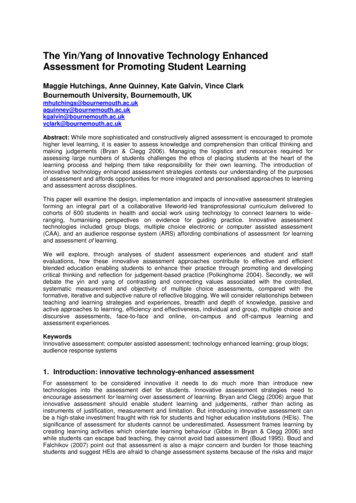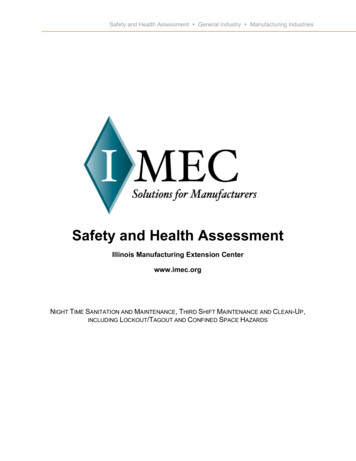
Transcription
Safety and Health Assessment General Industry Manufacturing IndustriesSafety and Health AssessmentIllinois Manufacturing Extension Centerwww.imec.orgNIGHT TIME SANITATION AND MAINTENANCE, THIRD SHIFT MAINTENANCE AND CLEAN-UP,INCLUDING LOCKOUT/TAGOUT AND CONFINED SPACE HAZARDS
Safety and Health Assessment General Industry Manufacturing IndustriesOccupational safety and health observations made during this assessment are informalobservations based on regulatory training, industry standards and safe and healthfulwork practices. This assessment cannot guarantee any facility would be in completecompliance with all regulatory standards at all times. Many workplace accidents areattributed to behavioral-based factors. Please note that standards set by the UnitedStates Department of Labor’s Occupational Safety and Health Administration (OSHA)are intended to be minimum standards. Many of these standards were adopted fromtrade organizations years ago. Under OSHA’s General Duty clause, employers arerequired to protect employees from all recognized hazards that are likely to cause deathor serious injury.Top Cited Manufacturing General Duty Clause Violations (2004 Region V - Illinois)1)2)3)4)5)6)7)8)9)10)No magnetic motor restarts for saws (ANSI B11.10)Unprotected foot pedal for shears and other equipment (ANSI B11 series)Not wearing seat belts for forklifts (ANSI B56.1)Not doing hoist and underhung crane inspections (ANSI B300.11/B30.16)Incompatible storage of acids and cyanidesStanding on pallet on forklift (ANSI B56.1)Exceeding hoist capacity (ANSI B30.16)Forklift platform with no capacity, Back of platform not screened, or weight of platform not marked (ANSI B56.1)Homemade lifting devices not proof tested or have a designed capacity (ANSI B30.20)No emergency stops for conveyorsMost Frequently Cited Violations (2007 Region V – .1471910.23No machine guarding, rotating partsNo hazcom programNo general machine guardingNo lockout/tagout programNo hazcom trainingNo lockout/tagout auditsNo lockout/tagout proceduresNo PPE hazard assessmentNo lockout/tagout trainingNo walking and working surfaces guardingThis material was produced under grant number SH-16626-07-60-F-17 from theOccupational Safety and Health Administration, U.S. Department of Labor. Itdoes not necessarily reflect the view or policies of the U.S. Department of Labor,nor does mention of trade names, commercial products, or organizations implyendorsement by the U.S. Government.
Safety and Health Assessment General Industry Manufacturing IndustriesDate, Company, and Contact NameAssessment TeamEmploymentThis information is needed for data compilation to meet OSHA reporting requirements for this grantprogram. Ask the company what shifts they are running (production and/or cleaning/maintenance). First,fill in the shift hours (e.g., 7 a.m. – 3 p.m.) followed by the number of salaried, hourly, total, and contractemployees for each shift. Remember that there may be off-shifts for cleaning/maintenance.Shift HoursSalariedHourlyTotal EmployeesContract WorkersOpening or Closing Conference:Ask the client if they would prefer to take the plant tour first or sit down and discuss the assessment anddocumentation before the shop floor assessment.During the conference, explain to the client that:You are unlikely to be inspected by OSHA unless:1. An employee makes a complaint2. An employee is killed or seriously injured3. Facility is on an OSHA target inspection list based on prior injury and illness logs or targetedindustryDo you have an active safety committee or team?Yes or NoDo you offer Restricted/Light Duty to injured employees?Yes or NoDo you have a particular safety or health concern?
Safety and Health Assessment General Industry Manufacturing IndustriesHazard CommunicationAlso known as the right to know law, Hazard Communications is still one of the mostfrequently cited OSHA standards. Employees must understand the chemicals theywork with, how to protect themselves from the hazards and what actions to take in anemergency situation. All employees should review material safety data sheets (MSDS)in their work areas and understand company labeling programs. Employees shouldhave the awareness level to obtain assistance and quickly locate the appropriate MSDSin an emergency and obtain pertinent first aid information for medical response. Are MSDS accessible to employees and organized for quick reference?Yes or No How are MSDS organized and maintained? Are containers properly labeled?Yes or No Are appropriate secondary containers being utilized?Yes or No Do employees understand the concepts of chemical incompatibility? Comments/additional information
Safety and Health Assessment General Industry Manufacturing IndustriesPersonal Protective Equipment (PPE)PPE is a last resort used to protect employees only when hazards cannot be eliminatedthrough engineering, safeguarding and/or work practices. Employers must document inwriting when, where and what PPE is required and train employees on thoserequirements and proper use and maintenance of that equipment. Are employees wearing appropriate PPE? If no, is it available to them?Yes or No Is there signage indicating appropriate PPE? Are rules being enforced?Yes or No Have you documented job hazard assessments with specific PPE requirements?Yes or No Is PPE properly maintained?Yes or No Comments/additional information
Safety and Health Assessment General Industry Manufacturing IndustriesLockout/TagoutThe control of hazardous energy should be a top training priority for manufacturers. Allplant employees should receive awareness level training. Maintenance staff and othersperforming lockout/tagout should receive more in-depth training, including required,company-specific written procedures for equipment with dual sources of energy. Is there a written program?Yes or No Have employees been trained on the program in the last year?Yes or No Are the locks and equipment available?Yes or No Are employees using the equipment consistently?Yes or No Are specific procedures documented for equipment with multiple sources?Yes or No Is an annual audit of authorized persons documented?Yes or No Are there magnetic motor restarts for saws (ANSI B11.10)?Yes or No Comments/additional information
Safety and Health Assessment General Industry Manufacturing IndustriesElectricalElectricity is one of the most common causes of fire in homes and workplaces.Electrical accidents appear to be caused by a combination of three factors:1. Unsafe equipment and/or installation;2. Workplaces made unsafe by the environment; and3. Unsafe work practices.There are various ways of protecting people from the hazards caused by electricity.These include insulation, guarding, grounding, electrical protective devices, and safework practices. Has the company addressed NFPA 70E (arc flash) requirements?Yes or No Are all electrical systems enclosed, such as all wiring in conduit, breaker panels closed?Yes or No Are all circuits and disconnects labeled?Yes or No Do you perform any electrical over 600 volts? If yes, who and what is/are their qualification(s)?Yes or No Is temporary wiring used correctly?Yes or No Is GFCI used where applicable?Yes or No Are explosion-proof systems in hazardous environments?Yes or No Comments/additional information
Safety and Health Assessment General Industry Manufacturing IndustriesMachine GuardingMachine guarding is a topic that should be addressed annually in company-widetraining. Activities such as machine safety and workstation design should be viewed ascontinuous improvement projects. Schedule reviews with cross functional teams andoutside experts as necessary. Have you assessed each machine or process to see if it is effectively guarded?Yes or No During the walkthrough, do you see any missing guards or unguarded operations?Yes or No Are guarding systems being maintained and inspected (interlocks, etc)?Yes or No Are you doing P.M.s on Mechanical Presses, inspecting brakes and clutches?Yes or No Are there unprotected foot pedals for shears and other equipment (ANSI B11 series)?Yes or No Are there emergency stops for machines, equipment, conveyors?Yes or No Comments/additional information
Safety and Health Assessment General Industry Manufacturing IndustriesSanitation and Industrial HygieneIndustrial hygiene encompasses many areas, including several previously stated.Additional areas of consideration include overall hygiene practices in industrial facilitiesand monitoring activities. During hazard communications training and at other times asappropriate, remind employees of the importance of proper hand washing and care ofPPE to minimize exposure to infectious illnesses and to chemicals through ingestion orabsorption. Employees frequently take breaks where they eat and smoke without takingthe time to wash their hands. Industrial employees become complacent and frequentlydo not consider that chemicals as common as WD-40 can have adverse health affects. Are break areas designated?Yes or No Are break areas cleaned daily?Yes or No Are adequate restroom facilities available and are they cleaned daily?Yes or No Are basic employee conduct policies implemented, such as hand washing, smoking, spitting tobacco?Yes or No Are emergency exits and aisle ways maintained?Yes or No Is there a housekeeping program in place? (Is it effective, have you observed trip hazards?)Yes or No Is the housekeeping program managed? Who is responsible? When? How Often? How?Yes or No Comments/additional information
Safety and Health Assessment General Industry Manufacturing IndustriesConfined SpacesThe purpose of this program is to ensure that safe work methods are utilized prior toand during all work activities performed on confined spaces. This program is designedto prevent personal injuries and illnesses that may be prevalent in confined spaces. Does the facility have confined spacesYes or No If yes, are the confined spaces designated with signage?Yes or No Have procedures been developed for each of the confined spaces?Yes or No Have employees been trained on the specific procedures?Yes or No Are “authorized entrants” established?Yes or No Is annual refresher training provided?Yes or No Are proper emergency systems/equipment in place (gas meter, harness, tripod, etc.)?Yes or No Have staff been trained on the equipment in the environment?Yes or No Comments/additional information
Safety and Health Assessment General Industry Manufacturing IndustriesComments and Recommendations
Safety and Health Assessment General Industry Manufacturing IndustriesReference MaterialsHazard Communication, Refer to 29 CFR ions/index.htmlPersonal Protective Equipment, Refer to 29 CFR 1910, Subpart ent/index.htmlLockout/Tagout, Refer to 29 CFR nergy/index.htmlElectrical, Refer to 29 CFR 1910 Subpart hine Guarding, Refer to 29 CFR 1910, Subpart mlOSHA Assistance for the Cleaning leaningindustry/index.htmlConfined Space, Refer to 29 CFR dex.html
9) Homemade lifting devices not proof tested or have a designed capacity (ANSI B30.20) 10) No emergency stops for conveyors Most Frequently Cited Violations (2007 Region V - Illinois) 1) 1910.212 No machine guarding, rotating parts 2) 1910.1200 No hazcom program 3) 1910.212 No general machine guarding

